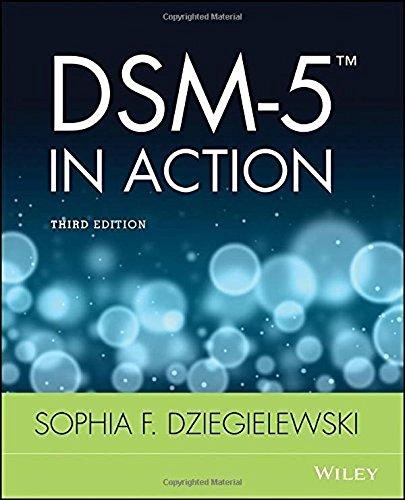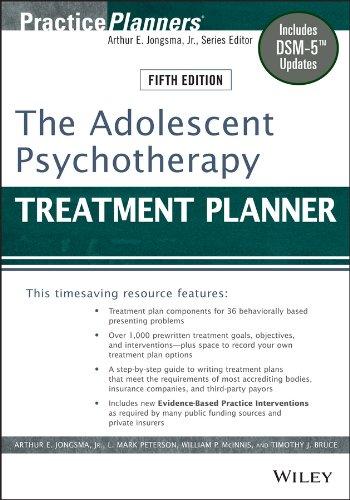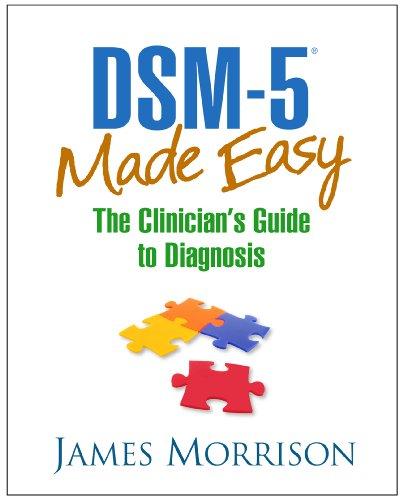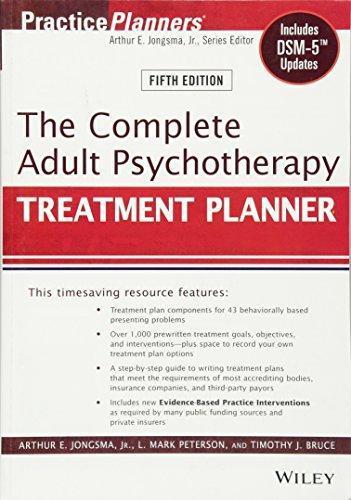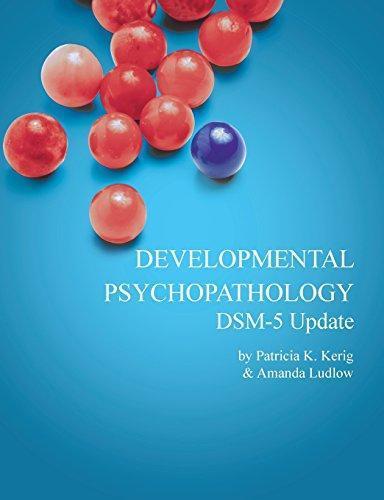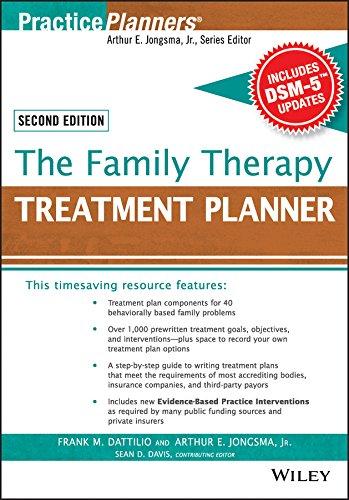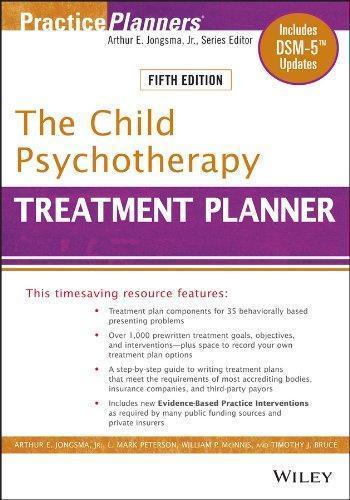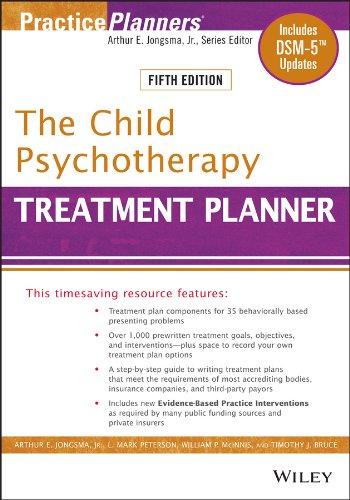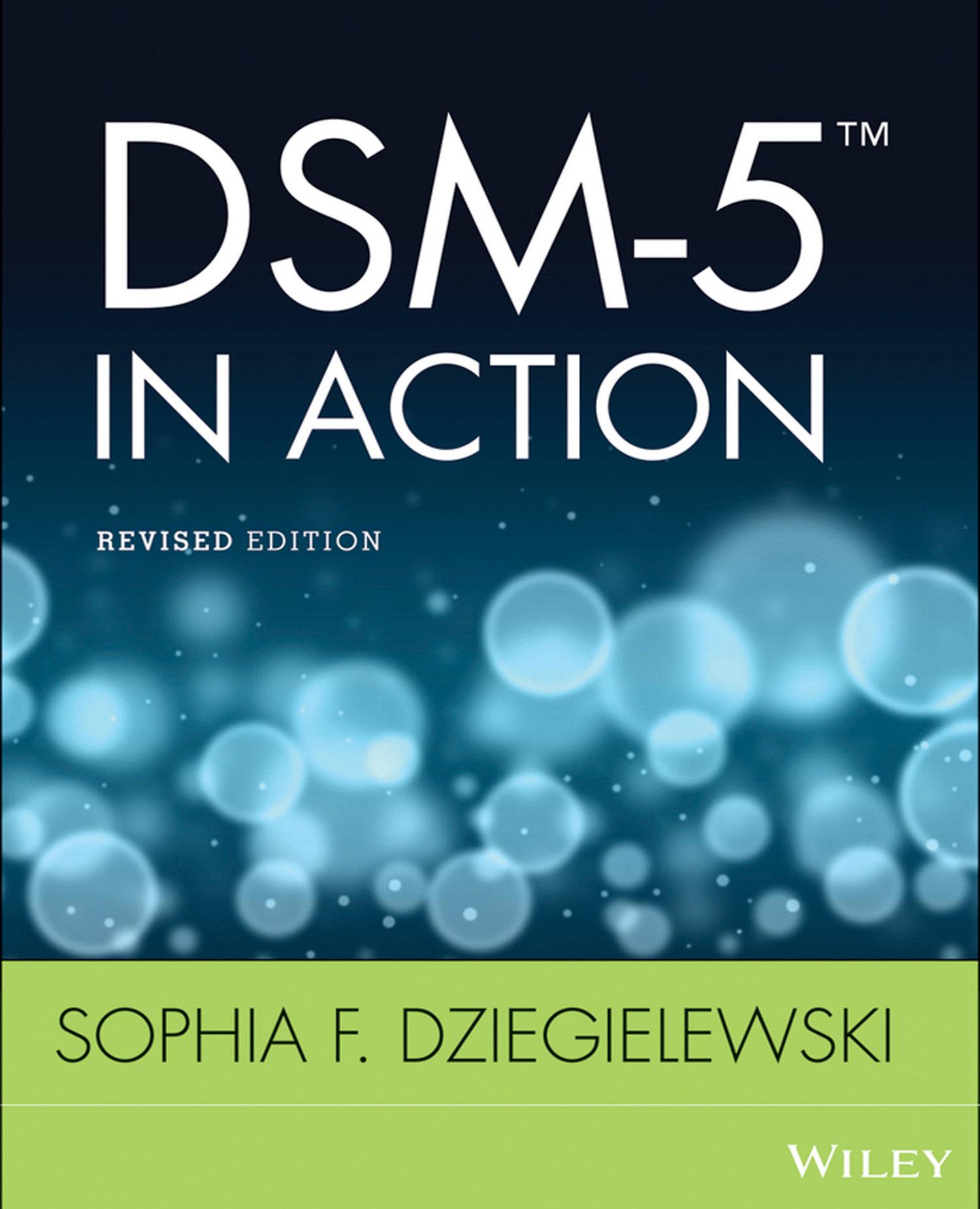DSM 5 in Action 3rd Edition (Ebook PDF) Visit to download the full and correct content document: https://ebookmass.com/product/dsm-5-in-action-3rd-edition-ebook-pdf/
More products digital (pdf, epub, mobi) instant download maybe you interests ...
English in Action 2 3rd
Edition Foley
https://ebookmass.com/product/english-in-action-2-3rd-editionfoley/
The Adolescent Psychotherapy Treatment Planner: Includes DSM 5 Updates (PracticePlanners) 5th Edition, (Ebook PDF)
https://ebookmass.com/product/the-adolescent-psychotherapytreatment-planner-includes-dsm-5-updates-practiceplanners-5thedition-ebook-pdf/
DSM-5? Made Easy: The Clinician’s Guide to Diagnosis 1st Edition – Ebook PDF Version
https://ebookmass.com/product/dsm-5-made-easy-the-cliniciansguide-to-diagnosis-1st-edition-ebook-pdf-version/
The Complete Adult Psychotherapy Treatment Planner: Includes DSM-5 Updates – Ebook PDF Version
https://ebookmass.com/product/the-complete-adult-psychotherapytreatment-planner-includes-dsm-5-updates-ebook-pdf-version/
Developmental Psychopathology with DSM-5 Update 6th Revised ed. Edition
https://ebookmass.com/product/developmental-psychopathology-withdsm-5-update-6th-revised-ed-edition/
The Family Therapy Treatment Planner, with DSM-5 Updates, 2nd Edition (PracticePlanners) – Ebook PDF Version
https://ebookmass.com/product/the-family-therapy-treatmentplanner-with-dsm-5-updates-2nd-edition-practiceplanners-ebookpdf-version/
Environmental Sociology: From Analysis to Action 3rd Edition, (Ebook PDF)
https://ebookmass.com/product/environmental-sociology-fromanalysis-to-action-3rd-edition-ebook-pdf/
The Child Psychotherapy Treatment Planner: Includes DSM-5 Updates 5th Edition
https://ebookmass.com/product/the-child-psychotherapy-treatmentplanner-includes-dsm-5-updates-5th-edition/
The Child Psychotherapy Treatment Planner: Includes DSM 5 Updates (PracticePlanners Book 294) 5th Edition, (Ebook PDF)
https://ebookmass.com/product/the-child-psychotherapy-treatmentplanner-includes-dsm-5-updates-practiceplanners-book-294-5thedition-ebook-pdf/
Preface
Utilizingthe
Introduction3
BeginningtheProcess3
MakingtheDiagnosticAssessment:ToolsThatFacilitatetheAssessment Process4
RoleofSocialWorkersandOtherMentalHealthProfessionals4
Developmentofthe DSM ClassificationSystem:HistoryandReservations6
DiagnosticLabels14
AnotherMentalHealthAssessmentMeasure16 ProfessionalTrainingintheProfessionalCounselingFields18 Summary19
QuestionsforFurtherThought20
References20
Utilizingthe DSM-5 inthePracticeSetting23
WorkingasPartofaTeam:ConnectionsandCollaborations25
DiagnosisandAssessment:IsThereaDifference?28
ACombinationApproach:TheDiagnosticAssessment33
DSM-5 UpdatesandStructuralChanges35
DSM-5:SectionsandAppendices39
ImportantSectionsinthe DSM-5 45
Culture,Age,andGender-RelatedInformation47 ConceptsofDistress53
CultureandOtherDiagnosticAssessmentFactorsRelatedtoAge57
CultureandOtherDiagnosticAssessmentFactorsRelatedtoGender59
Summary66
QuestionsforFurtherThought67
References67
Chapter3CompletingtheDiagnosticAssessment 70
BasicsforCompletingaComprehensiveDiagnosticAssessment70
DSM-5 andCompletingtheDiagnosticAssessment74
ThePrincipalDiagnosis76
SubtypesandCourseSpecifiers86
EthicalandLegalConsiderations101
PullingItAllTogether102
Summary104
QuestionsforFurtherThought105
References105
Chapter4Applications 107
Documentation,TreatmentPlanning,andPracticeStrategy107 TreatmentandInterventionPlanning116
DevelopingtheTreatmentPlan120
SelectinganInterventionFramework123
PracticeStrategyandApplication127
TypesofTime-LimitedTherapyinMentalHealthPractice131
Summary140
QuestionsforFurtherThought143
References143
SECTION II
DiagnosticandTreatmentApplications
Chapter5SchizophreniaSpectrumandtheOther PsychoticDisorders149
SophiaF.Dziegielewski
Introduction149
TowardaBasicUnderstandingoftheConditions150 UnderstandingIndividualsWhoSufferFromthePsychoticDisorders151 ImportantFeaturesRelatedtothePsychoticDisorders153
DSM-5:AssessmentofSymptomsMeasurement157 OverviewofSchizophreniaSpectrumandOtherPsychoticDisorders160 Schizophrenia167
BeginningtheDiagnosticAssessment173
SchizophreniaandFactorsforConsiderationintheDiagnosticAssessment174
CaseApplicationoftheDiagnosticAssessment181
TreatmentPlanningandInterventionStrategy186
SpecialTopics195
SummaryandFutureDirections196
References197
Chapter6BipolarandRelatedDisorders
SophiaF.DziegielewskiandOlgaMolina
Introduction202
TowardaBasicUnderstandingoftheBipolarandRelatedDisorders202 UnderstandingIndividualsWhoSufferFromBipolarandRelated Disorders204
OverviewoftheBipolarandRelatedDisorders212 SummaryofBipolarDisorders221 DiagnosticAssessmentinAdultsWithBipolarDisorder222
GeneralInterventionStrategies:ModelsandTreatmentModalitiesforthe BipolarDisorders232
SpecialTopics236
SummaryandFutureDirections238 References239
Chapter7DepressiveDisorders
SophiaF.Dziegielewski
Introduction242
TowardaBasicUnderstandingoftheDisorders243 ImportantFeaturesRelatedtotheDepressiveDisorders244 EndogenousandExogenousDepression:MakingaDistinction246 OverviewoftheDepressiveDisorders247 TheDepressiveDisordersandtheDiagnosticAssessment259 SpecialTopics270 AssessmentofDangertoSelforOthers271
SummaryandFutureDirections272
References273
Chapter8Obsessive-CompulsiveandRelatedDisorders
SophiaF.DziegielewskiandBarbaraF.Turnage
Introduction278
TowardaBasicUnderstandingoftheObsessive-CompulsiveandRelated Disorders278
UnderstandingIndividualsWhoSufferFromtheOCDSpectrumDisorders: WhenUrgesBecomeOverwhelming280 ImportantFeaturesRelatedtotheObsessive-CompulsiveandRelated Disorders281
OverviewoftheObsessive-CompulsiveandRelatedDisorders283 TowardaBetterUnderstandingofObsessive-CompulsiveDisorder289 Obsessive-CompulsiveDisordersandtheFactorsforConsideration intheDiagnosticAssessment291 SummaryandFutureDirections306 References306
Chapter9Trauma-andStressor-RelatedDisorders 309 SophiaF.DziegielewskiandBarbaraF.Turnage
Introduction309
TowardaBasicUnderstandingofTrauma-andStressor-RelatedDisorders309 UnderstandingIndividualsWhoSufferFromtheTrauma-andStressor-Related Disorders310
ImportantFeaturesRelatedtotheTrauma-andStressor-Related Disorders311
OverviewoftheTrauma-andStressor-RelatedDisorders313 BeginningtheDiagnosticAssessment321 PullingItAllTogether:AnIntegratedApproach333 SummaryandFutureDirections335 References335
Chapter10SexualDysfunctions 338 SophiaF.DziegielewskiandJoshuaKirven
Introduction338
TowardaBasicUnderstandingoftheSexualDysfunctions338 IndividualsWhoSufferFromaSexualDysfunction340 ImportantFeaturesandTermsRelatedtotheSexualDysfunctions341 OverviewoftheSexualDysfunctions343 SexualDysfunctionsandtheDiagnosticAssessment353 CompletingtheDiagnosticAssessment353 OverviewofTreatmentMethodsfortheSexualDisorders358 SelectedAssessmentScalesandMethodsforTreatingtheSexualDisorders361 SpecialTopics364
ApplyingaCulturalCompetenceLenstoDiagnosis367 SummaryandFutureDirections369 References370
Chapter11DisruptiveImpulse-ControlandConductDisorders375
SophiaF.DziegielewskiandAnaM.Leon
Introduction375
LivingWithProblematicSelf-ControlofEmotionsandBehavior376 OverviewoftheDisruptive,Impulse-Control,andConductDisorders377
TheDiagnosticAssessment:ApplicationBasics387 GeneralInterventionStrategies:ModelsandTreatmentModalities403
SummaryandFutureDirections411
References412
Chapter12Substance-RelatedandAddictiveDisorders SophiaF.Dziegielewski
TowardaBasicUnderstandingoftheSubstance-RelatedandAddictive Disorders418
UnderstandingtheIndividualsWhoSufferFromtheSubstanceDisorders419 OverviewoftheSubstance-RelatedandAddictiveDisorders425 BeginningtheDiagnosticAssessment:Alcohol-RelatedDisorders436 TreatmentPlanningandInterventionStrategy445
BriefInterventionsinPrimaryCareSettings453
TopicsofInterest456
MisuseofPrescriptionMedications461
SummaryandFutureDirections462 References463
Chapter13PersonalityDisorders SophiaF.DziegielewskiandGeorgeA.Jacinto
Introduction467
TowardaBasicUnderstandingofthePersonalityDisorders468 UnderstandingIndividualsSufferingFromaPersonalityDisorder468 WhatIsaPersonalityDisorder?471
ClusterAPersonalityDisorders471
ClusterBPersonalityDisorders475
ClusterCPersonalityDisorders482
OtherPersonalityDisorders485
SummaryofthePersonalityDisorders487
BorderlinePersonalityDisorder(BPD)487
StrategiesforIndividualTherapyandIntervention500
SectionIII:Alternative DSM-5 ModelforthePersonalityDisorders502
SummaryandFutureDirections503 References504
AuthorIndex
Preface Thepagesthatfollowwillintroducethe readertothediagnosticassessment,with itsobviousstrengthsaswellasitslimitations. Althoughtheconceptofdiagnosisandassessmentisrichintradition,theconnectionbetween diagnosticproceduresandbehavioral-basedoutcomescallsforapracticestrategythatrecognizes theimportanceoftherelationshipbetweenthe problemsandconcernsofthepersonandhisor herenvironment.Continuallyassessingandreassessinghowtobestaddresscontextchanges relatedtoemotional,physical,andsituational factorsregardingclientwell-beingisparamount.
Thisbookstressesamultidisciplinaryand interdisciplinaryfocusthatinvitesallmedically andnonmedicallytrainedprofessionals,social workers,andothermentalhealthpractitioners tojoininacollaborativeteam-basedapproach. Byworkingtogether,teamsbestserveclients’ needsbyprovidingacomprehensivediagnostic assessmentthatensureshigh-qualitycare.
Thisbookutilizesthediagnosticnomenclatureoutlinedinthe DiagnosticandStatistical ManualofMentalDisorders (DSM)andgoes beyondthe DSM toclearlysuggesttreatment planningandapplication.Thediagnosticassessmentisembeddedintheuseofsupportingtexts, alsoreferredtoasthebiblesofmentalhealth, suchasthe DiagnosticandStatisticalManualof MentalDisorders,5thed.(DSM-5;American PsychiatricAssociation,2013)andthe InternationalClassificationofDiseases, ninthand10th editions(ICD-9-CM and ICD-10-CM;World HealthOrganization,1993,2008).Thesebooks
havebeenthestandardsformentalhealthpracticefordecades.Therefore,itshouldcomeasno surprisetomentalhealthprofessionalsthatthe newedition,the DSM-5, whichcrosswalks insurancebillingwiththe ICD-10, withitslatest mandatoryrequirementforusageinOctober 2015,willbringwhatsomeconsiderearth-shakingchanges.
Familiaritywiththesebooksisimportantfor completingthediagnosticassessment,andall mentalhealthprofessionalsneedtounderstand thisinformationandhowtoincorporateitto provideacompetent,efficient,andeffectivepracticestrategy.Toassistinthisprocess,thisbook outlinesthebasicdiagnosticinformationrelatedto the DSM-5 andsuggeststreatmentstrategy.
Similartopreviouseditions,thiseditionof thistextcontinuestoserveasahandbookthat extendsbeyondjustlearningthecriteriafora diagnosis.Afterprovidinganoverviewofthe basics,thetextextendstotreatmentstrategywith thecreationoftreatmentplans,includingsuggestionsforindividualizingthebesttherapeutic servicesavailable.Inusingthe DSM, concerns remainaboutmisdiagnosis,overdiagnosis,and labelingclients allpracticesthatcanhave severerepercussionspersonally,medically, socially,andoccupationally andtheneedfor informed,ethicalpracticehasneverbeenmore important.Theearlystagesoftransitiontothe DSM-5 willrequirebalancingtheknowledgeof bothbooks,the DSM-IV-TR and DSM-5.Mental healthpractitionersbelievestronglyinallowingethicalprinciples,environmentalfactors,and
arespectforculturaldiversitytoguideallpractice decisions.Fromthisperspective,thediagnostic assessmentdescribedinthisbookembodiesconceptssuchasindividualdignity,worth,respect, andnonjudgmentalattitudes.
Forsocialworkersandothermentalhealth counselors(oftenreferredtoaspractitioners), recognizingthesevaluesisthecornerstone fromwhichalltreatmentplanningandinterventionisbuilt.Manytimestheseconceptsremain subjectiveandrequireprofessionalacknowledgment,interpretation,andapplicationextending beyondtheformaldiagnosticcriteriaandrequiringinterpretationandapplicationstrategiesthat leadtoefficientandeffectivepracticestrategy. Whatismostimportanttorememberisthatthe DSM, regardlessoftheversion,doesnotsuggest treatment.Myhopeisthatthisbookwillhelpto furtherthecrosswalkasthe DSM workswiththe ICD intermsofbillingandthatthisbookwill outlineacomprehensivediagnosticassessment leadingdirectlytothetreatmentandtreatment planningessentialfortheimplementationof practicestrategy.
OVERVIEW Tostartthisendeavor,thefourchaptersof SectionIintroducethereadertothemajor diagnosticassessmentschemesutilizedinthe professionandthroughthisdiagnosticlensoutlinebothsupportandresistanceissues.Inthese introductorychapters,thebasicsofdiagnosisand assessmentareexemplifiedinrelationtohow thesetermsareappliedincurrenthealthand mentalhealthpractice.Thelearningprocess beginswithanunderstandingofhowterms suchas diagnosis and assessment arecombinedin relationtocurrenthealthandmentalhealth practice.Ahistoricalperspectiveprovidesthe backgroundofthe DSM, comparingthesimilaritiesanddifferencesfrompreviouseditions
andtherationaleforthelatestversion,the DSM-5.Further,thissectionsummarizesthe currentexpectationsandcontroversiessurroundingthe DSM-5. Takenintoaccountin DSM-5 is theimportanceofincludingsupportinginformation,suchasuseofthedimensionalassessment, crosscuttingofsymptoms,anduseoftheCultural FormulationInterview(CFI).Itendswithan overviewofhowthe “InAction” connectionis made,linkingthediagnosticimpressiontotreatmentplanningandpracticestrategy.Caseexamplesshowtheapplicationofthetheoretical conceptsanddemonstratehowtheseprinciples relatetopracticestrategy.
SectionIIprovidescomprehensivediagnosticinformationforeachselectedcategoryof disorder,identifyingcommonlyseenpsychiatric mentalhealthconditions.Eachchaptercontains QuickReferences designedtohighlightthemost importantdiagnosticcriteriaclearlyandconcisely.Thecaseexamplesshowhowthecriteria canmanifest.Foreachcategoryofdisorders outlinedintheapplicationchapters,atleast onedisorderhighlightsthe “InAction” focus ofthebook.Thecaseexampleprovidesacomprehensivediagnosticassessmentandtreatment planthatreflectstherelatedpracticestrategy.
Additionaltreatmentplanswereoneofthe mostpopularfeaturesofpreviouseditionsofthis book,andtheyhavebeenexpanded.Treatment planningisessentialtopracticestrategy,and regardlessofwhetherthe DSM orthe ICD is used fordiagnosticpurposes,thetreatmentplans andinterventionstrategywillremainsimilar. Therefore,theappendixcoversselecteddisordersnotaddressedintheindividualchapters,and alsoaddedareselectedquickreferencesthat clearlyoutlinethecriteria.Eachtreatment planexplainsthesignsandsymptomsthatshould berecorded,whattheshort-andlong-range goalsfortheclientare,andwhatneedstobe donebytheclient,thepractitioner,andthe family.
UniquenessofThisBook Whatremainsuniqueaboutthisbookisthatit challengesthepractitionertosynthesizeinformationintoacompletediagnosticassessment thatbridgesthediagnosticassessmenttocurrent treatmentplanningandpracticestrategy.Each chapter,alongwiththequickreferences,is designedtogivehealthandmentalhealthpractitionersasenseofhands-onlearningandparticipation.Thisbookisnotmeanttoincludeall aspectsofamentaldisorderanditssubsequent treatment.Rather,itprovidesaframeworkfor approachingthedisorder,withsuggestionsfor thetreatmentthatwillfollow.
Therefore,thisbookprovidesareaderfriendlycomprehensivereferencetothemost commonlydiagnosedmentaldisorders,aswellas specificapplicationsdesignedtoshowhowto applythediagnosticframeworktowardcurrent practicestrategy.Eachdisorderwascarefully selected,basedonwhatismostoftenseenin the fieldandtaughtinthegraduate-levelclassroom.Inaddition,basedontheprevalenceof thesediagnoses,thedisorderscoveredinthis bookareoftenincludedonsocialworkand othermentalhealth–relatedlicensingexams.
Onapersonalnote,Ibelievecreatinga reader-friendly,practice-basedhandbookofthis natureisnevereasy norshoulditbe.Creating thebestdiagnosticassessmenttakesalotofhard work,andallpracticewisdommustbegrounded inindividualized,evidence-basedpracticestrategy.Therefore,theactualdraftingofchaptersof thiseditionfromthe firstproposaltotheend productcoveredaspanofwellover4years,with numerousrewritesandedits.Thisbookrepresents morethan25yearsofmyprofessionalpracticeand teachingexperience.Inaddition,Ihaveworked withallthecontributingauthorsoftheapplication chapters,allarefellowpractitionersinthearea,
andtogetherwehavespentcountlesshoursdecidingonhowbesttotranscribepracticeexperience intothewrittenword.Allthecontributorstothis textarepassionateaboutourprofessionandagree thatmuchneedstobelearnedfromtheclients served.Weallbelievestronglythatdiagnosticskill willalwaysfallshortifitisnotlinkedtopractice strategy.
Caseexamplesareusedthroughoutthis booktohelpthereaderseetheinterfacebetween whatiswritteninthetextandhowitappliesto practice.Manyofthestrugglesthatotherprofessionalshavenotedarehighlighted,andthe caseexamplespresentinformationinapractical andinformativewaythatissensitivetothe client’sbestinterestswhiletakingintoaccount therealityofthepracticeenvironment.Thus, thecontributorsinvitethereadertobeginthis adventureinlearningandtorealizethatdiagnosticassessmentneedstobemorethan “the BlindManandtheElephant.”
Therewillalwaysbeasubjectivenatureto diagnosisandassessment,justasthereisasubjectivenaturetoindividualsandthebestemployedinterventionstrategy.Thepersonin-situationstanceprovidesthestrongestlink tothesuccessfuldiagnosticassessment,which canoftenbeoverlooked.Thisedition,likethe onesbeforeit,isintendedtotakethepractitioner beyondthetraditionaldiagnosticassessmentand igniteacreative fireforpracticestrategyand implementation,similartowhatithasdonefor thoseinourprofession.Theimportanceofthe person-in-environmentandofincludingsupportivecharacteristicsrelatedtoindividuals,families,andtherelatedsupportsystemwillalways standintheforefrontofthesuccessfulapplication oftreatmentstrategy.Welcometothislatest edition,andwitheachclientserved,Ihope youneverforgettheimportanceofthethree Rs:Recognition,Respect,andResponsibility.
REFERENCES AmericanPsychiatricAssociation.(2013). Diagnosticand statisticalmanualofmentaldisorders (5thed.).Arlington, VA:AmericanPsychiatricPublishing.
WorldHealthOrganization.(1993). Internationalclassificationofdiseases:Mentaldisorders (10thed.).Geneva, Switzerland:Author.
WorldHealthOrganization.(2008). ICD-10:International statisticalclassificationofdiseases:Clinicalmodification (10threv.ed.).NewYork:NY:Author.
Acknowledgments IamverygratefulforallthehelpIhave receivedfromthecoauthorsontheapplicationschaptersincludedinthistext.Thesharing ofsuchexperiencedpractitioners’ firsthand experienceshasbeeninvaluable.Iwouldalso liketothankthe18,000socialworkersand counselorsthatIhavetrainedforprofessional practiceinsupervisionandfortakingthesocial worklicensureexams.Theirwonderfulfeedback intermsofwhattheyareseeinginthe fieldand theproblemstheyhaveencounteredhashelped metobecomeastrongerteacherandpractitioner.Forthisinput,Iwillalwaysbethankful andintendtocontinuetogivebackasmuchas possibletohelpothersalongtheirprofessional journey.Asmentalhealthpractitioners,regardlessofdiscipline,notonlydowehaveaclearpath setbeforeustodealwiththechallengesofthis changingenvironmentbutalsowebearthe burdenofexploringandsubsequentlyinfluencinghowthesechangeswillaffectourprofessional practiceandtheclientsweserve.
Iwouldliketothankmyclientsforteaching metheimportanceofgoingbeyondwhatis expectedandrecognizingtheuniquenessof eachindividualIhavehadtheprivilegeof serving.Seeing firsthandthestigmaandsubsequentdangerofplacingalabelonaclienthasleft mesensitivetoensuringthatthediagnostic assessmentisnotdonehaphazardlyandalways takesintoaccounttheperson-in-situationor person-in-environmentperspective.Thismeans thateachencountermust firstrecognizethe uniquenessoftheindividual,showrespectfor
theclientandhisorhersituation,andtake responsibilityforprovidingthemostcomprehensivediagnosticassessmentandsubsequent treatmentavailable.
Furthermore,the finalproductisonlyas goodasthosewhoworkdiligentlybehindthe scenesontheeditingandproductionofthis book.First,IwouldliketothankBarbaraMaisevich,MSW,forhersecondsetofeyesand technicalsupportincompletingthismanuscript. IwouldalsoliketothankRachelLivsey,Senior Editor,SocialWorkandCounseling,andKim Nir,editor “extraordinaire” atJohnWiley& Sons.Iwouldliketothankbothoftheseindividualsfortheiropennesstonewideas,high energylevel,drive,ambition,andperseverance makingthembothwiseteachers,mentors,colleagues,andnowmyfriends.
Last,Iwanttothankmyfamilymembers, friends,andcolleagueswhounderstoodand supportedmewhenIsaidIcouldnotparticipate becauseIhadtoworkonthisbook.Special thankstomyhusbandwhofor35yearsalways listensandunderstandsthestressanotherdeadlineplacesonourtimetogether.Iama firm believerthatthemorewesharewithothers,the greaterthegiftswereceiveinreturn.Therefore, itcomesasnosurprisethatIamblessedwith knowingandworkingwithsomanycaringand supportivefamilymembers,friends,andcolleagues.Withthatlevelofencouragementand support,allthingsreallyarepossible.
SophiaF.Dziegielewski
QuickReferenceList Chapter1GettingStarted
QuickReference1.1:BriefHistoryofthe DSM 8
QuickReference1.2:ReasonsforthePublicationofthe DSM-IV andthe DSM-IV-TR 11
QuickReference1.3:Intentofthe DSM-IV-TR 11
QuickReference1.4: DSM-5 ThreeSections13
QuickReference1.5:CategoricalSections:20DisordersandTwoAdditional Categories14
QuickReference1.6: DSM-5: PositiveAspects(PRO)andNegativeAspects (CON)15
Chapter2BasicsandApplication QuickReference2.1:MultidisciplinaryTeams26
QuickReference2.2:InterdisciplinaryTeams27
QuickReference2.3:TransdisciplinaryTeams27
QuickReference2.4:BasisforChangesinthe DSM-5 37
QuickReference2.5:BasicDefinitions37
QuickReference2.6:SupportingtheChangesandUseof DSM-5 38
QuickReference2.7: DSM-5: ThreeSections39
QuickReference2.8: DSM-5, SectionII40
QuickReference2.9:PresentationoftheDisorders45
QuickReference2.10:AssociatedFeaturesSupportingtheDiagnosis46
QuickReference2.11:IdentifyingCulturalAspects49
QuickReference2.12:CulturalFormulationInterview(CFI)51
QuickReference2.13:TakingIntoAccountCultureand CulturalFormulationInterview(CFI)52
QuickReference2.14:CreatingCulturalCompetence inPractitioners53
QuickReference2.15:SelectedCulturalConceptsofDistress54
QuickReference2.16:DiagnosticAssessmentWithChildren58
QuickReference2.17:DiagnosticAssessmentWithOlderAdults60
QuickReference2.18:GenderandtheDiagnosticAssessmentI61
QuickReference2.19:GenderandtheDiagnosticAssessmentII61
QuickReference2.20:ExamplesofCodingin DSM-5 66
Chapter3CompletingtheDiagnosticAssessment
QuickReference3.1:BiomedicalFactorsinAssessment71
QuickReference3.2:PsychologicalFactorsinAssessment72
QuickReference3.3:SocialandEnvironmentalFactorsin Assessment73
QuickReference3.4: DSM-IV-TR: MultiaxialAssessment75
QuickReference3.5:PrincipalandProvisionalDiagnosis76
QuickReference3.6:HelpfulTipsforDocumentingthePrincipal Diagnosis77
QuickReference3.7:TypicalAntipsychoticMedications80
QuickReference3.8:SelectedAtypicalMedications81
QuickReference3.9:Medication-InducedMovementDisorders82
QuickReference3.10:GeneralCategories83
QuickReference3.11:SubtypesandSpecifiers87
QuickReference3.12:CrosscuttingSymptomMeasure:Level1 andLevel289
QuickReference3.13:QuestionstoGuidetheProcess94
QuickReference3.14:HelpfulHints:ClinicalPresentations SuggestiveofaMentalDisorder95
QuickReference3.15:GeneralCategoriesforMedicalDiseasesand Conditions98
QuickReference3.16:ImportantQuestionsinAssessingMedical Symptoms99
QuickReference3.17:AssessingHearingandVisionProblems101
Chapter4Applications:BeyondtheDiagnosticAssessment
QuickReference4.1:OverviewofGuidingPrinciplesforEfficient Documentation110
QuickReference4.2:InformationtoBeIncludedinthePOR111
QuickReference4.3:SOAP,SOAPIE,andSOAPIERRecording Formats111
QuickReference4.4:DAPERecordingFormat113
QuickReference4.5:PIRPandAPIERecordingFormat114
QuickReference4.6:HelpfulHints:Documentation115
QuickReference4.7:No-Harm,No-RiskBehaviors: DiscussionPoints118
QuickReference4.8:SampleofIdentifiedProblemBehaviors121
QuickReference4.9:DefinitionsofTheoreticalConcepts126
Chapter5SchizophreniaSpectrumandtheOtherPsychoticDisorders149
QuickReference5.1:TypesofDelusions154
QuickReference5.2:PsychoticCharacteristicsandSymptoms158
QuickReference5.3:TypesofSchizophreniaSpectrumand OtherPsychoticDisorders161
QuickReference5.4:Jacob’sIdentifiedGoals186
QuickReference5.5:OlderorTypicalAntipsychoticMedicationsin Schizophrenia192
QuickReference5.6:GeneralConditionsandSideEffectswith AntipsychoticMedications193
QuickReference5.7:SelectedAnti-ParkinsonMedications194
QuickReference5.8:NewerorAtypicalAntipsychoticMedications194
Chapter6BipolarandRelatedDisorders202
QuickReference6.1:Neuroimaging203
QuickReference6.2:TypesofMoodEpisodes205
QuickReference6.3:DescriptionofBipolarMoodDisorders214
QuickReference6.4:FourSubgroupsofBipolarIDisorder216
QuickReference6.5:DiagnosticCriteriaforBipolarIIDisorder219
QuickReference6.6:MentalStatusDescription225
QuickReference6.7:SubstanceUse/Abuse228
QuickReference6.8:Characterizations,Symptoms,andBehaviors forDan230
QuickReference6.9:CounselingStrategiesforCognitiveTherapy forDan231
Chapter7DepressiveDisorders242 QuickReference7.1:DepressiveDisorders:BriefDefinitions247
QuickReference7.2:CounselingStrategiesforJoey267
QuickReference7.3:SelectiveSerotoninReuptakeInhibitors270
Chapter8Obsessive-CompulsiveandRelatedDisorders 278 QuickReference8.1:PresentationofAnxiety281
QuickReference8.2:ObsessionsandCompulsions282
QuickReference8.3:OverviewofObsessive-Compulsive andRelatedDisorders284
QuickReference8.4:MentalStatusDescription296
QuickReference8.5:IdentifyPrimaryandPresentingProblems forKurt298
Chapter9Trauma-andStressor-RelatedDisorders
QuickReference9.1:PresentationofAnxiety312
QuickReference9.2:MentalStatusDescription325
QuickReference9.3:IdentifyPrimaryandPresentingProblemsfor Marmarie326
Chapter10SexualDysfunctions QuickReference10.1:SexualDysfunctionsasCategorizedinthe DSM-5: BriefDescriptions344
QuickReference10.2:TreatmentPlanStrategy359
QuickReference10.3:GlossaryofSelectedCulturalConcepts ofDistress368
Chapter11Disruptive,Impulse-Control,andConductDisorders375
QuickReference11.1:SelectedCriteriaforOppositionalDefiant Disorder380
QuickReference11.2:ConductDisorder383
QuickReference11.3:IdentifyPrincipalDiagnosis/ReasonforVisitand PresentingProblem396
QuickReference11.4:RiskAssessment400
QuickReference11.5:MentalStatusDescription401
QuickReference11.6:BehavioralProblemIdentification403
QuickReference11.7:DischargeCriteria410
Chapter12Substance-RelatedandAddictiveDisorders
QuickReference12.1: DSM-5 ClarifyingImportantTerms422
QuickReference12.2: DSM-5 GeneralCategoriesforthe Substance-RelatedDisorders425
QuickReference12.3:ComparisonofSubstance-RelatedDisorders Between DSM-5 and DSM-IV/DSM-IV-TR 427
QuickReference12.4:HelpfulHints: DSM-5 NewCategorySubstance UseDisorder428
QuickReference12.5:SubstanceUseDisordersand Specifiers429
QuickReference12.6: DSM-5 HelpfulHintsfortheDiagnostic AssessmentofSubstanceUseDisorders430
QuickReference12.7:DisordersNotCoveredin DSM-IV-TR 432
QuickReference12.8: DSM-IV-TR Substances Polysubstance432
QuickReference12.9:CategoriesofSubstances:SubstanceIntoxicationand SubstanceWithdrawal433
QuickReference12.10:CommonEffectsofExcessiveAlcohol ConsumptionWithintheFamily441
QuickReference12.11:MentalStatusDescription442
QuickReference12.12:SupportiveConcerns444
QuickReference12.13:12StepstoRecovery453
QuickReference12.14:EarlyRecognitionofAlcohol-Related Problems458
Chapter13PersonalityDisorders467 QuickReference13.1:PersonalityDisordersasListedinEachEditionofthe DSM 470
QuickReference13.2:MentalStatusDescription494
QuickReference13.3:IdentifyPrimaryandPresentingProblem495
QuickReference13.4:RiskAssessment495
QuickReference13.5:IdentificationofProblematicBehaviors498
QuickReference13.6:TherapeuticGoals498
AppendixQuickReferences:SelectedDisorders—Criteria andTreatmentPlans
QuickReferenceA.1:IntellectualDisability508
QuickReferenceA.2:AutismSpectrumDisorder511
QuickReferenceA.3:Attention-Deficit/HyperactivityDisorder515
QuickReferenceA.4:SeparationAnxietyDisorder518
QuickReferenceA.5:GeneralizedAnxietyDisorder522
QuickReferenceA.6:InsomniaDisorder525
QuickReferenceA.7:HypersomnolenceDisorder530
QuickReferenceA.8:AnorexiaNervosa536
QuickReferenceA.9:BulimiaNervosa540
S ECTION I UTILIZINGTHE DSM-5 : ASSESSMENT, PLANNING,AND PRACTICESTRATEGY 1 CHAPTER GettingStarted INTRODUCTION Thischapterintroducestheconceptsandcurrent applicationprinciplesrelatingpsychopathology toclinicalmentalhealthpractice.Thisapplicationissupportedthroughtheuseandexplication ofdiagnosis-assessmentskillsfoundintoday’ s behavioral-basedbiopsychosocial fieldofpractice.Themajordiagnosticassessmentschemes utilizedintheprofession,alongwithsupportand resistanceissues,areintroduced.Diagnosisand assessmentareappliedtocurrentmentalhealth practice.Ahistoricalperspectiveisexplored,and thetypeofdiagnosticassessmentmostutilized todayisoutlined.Practicestrategyishighlighted, andconsiderationsforfutureexplorationand refinementarenoted.
BEGINNINGTHEPROCESS Theconceptofformulatingandcompletinga diagnosticassessmentisembeddedinthehistory andpracticeoftheclinicalmentalhealthcounselingstrategy.Sadler(2002)definedthetraditionalpurposeofthepsychiatricdiagnosisas providingefficientandeffectivecommunication amongprofessionals,facilitatingempirical researchinpsychopathology,andassistingin theformulationoftheappropriatetreatment strategyfortheclienttobeserved.Theimportanceofthediagnosticassessmentissupportedby estimatesrelatedtotheprevalenceofmental disordersinourpopulationandtheeffectsit
canhaveonhumanfunctionandproductivity.It isestimatedthateachyear,aquarterofAmericansaresufferingfromaclinicalmentaldisorder. Ofthisgroup,nearlyhalfarediagnosedwithtwo ormoredisorders(Kessler,Chiu,Demler,& Walters,2005).PaulaCaplan(2012),aclinical andresearchpsychologist,wroteinthe Washington Post thatabouthalfofallAmericanscanexpect togetapsychiatricdiagnosisintheirlifetime. Althoughonthesurfacethesenumbersmay seemalarming,someresearchersquestionwhether theseincidencesofmentaldisordersaresimply aproductofourtimesandrelatedprimarilyto thetaxonomyusedtodefineamentaldisorder (Ahn&Kim,2008).Inpractice,thisrichtradition relatedtomakingthediagnosticimpression hasbeenclearlyemphasizedbycompelling demandstoaddresspracticereimbursement (Braun&Cox,2005;Davis&Meier,2001; Kielbasa,Pomerantz,Krohn,&Sullivan,2004; Sadler,2002).Forexample,whetheraclienthas healthinsurancecanbeafactorinwhetherhe orshegetsamentalhealthdiagnosisandthe supportingtreatmentreceived(Pomerantz& Segrist,2006).Also,useofthe DSM andcreating apsychiatricdiagnosiscontinuetogobasically unregulatedandopentoprofessionalinterpretation(Caplan,2012).
Tofacilitatemakingthediagnosticimpression,numeroustypesofdiagnosisandassessment measurementsarecurrentlyavailable manyof whicharestructuredintouniquecategoriesand classificationschemes.Allmentalhealthprofessionalsneedtobefamiliarwiththetextsoften
referredtobythoseinthe fieldasthebiblesof mentalhealthtreatment.Theseresources,representingthemostprominentmethodsofdiagnosis andassessment,aretheonesthataremostcommonlyusedandacceptedinhealthservicedelivery.Althoughitisbeyondourscopetodescribe thedetailsandapplicationsofallofthesedifferenttoolsandthecriteriaforeachofthemental disordersdescribed,familiaritywiththosemost commonlyutilizedisessential.Furthermore,this booktakesthepracticingprofessionalbeyond assessmentbypresentingthemostcurrentmethodsusedtosupportthediagnosticassessmentand introducinginterventionsbasedoncurrentpracticewisdom,focusingonthelatestevidencebasedinterventionsutilizedinthe field.
MAKINGTHEDIAGNOSTIC ASSESSMENT:TOOLSTHAT FACILITATETHEASSESSMENT PROCESS Fewprofessionalswoulddebatethatthemost commonlyusedandacceptedsourcesofdiagnosticcriteriaarethe DiagnosticandStatisticalManualof MentalDisorders,FifthEdition (DSM-5 )andthe InternationalClassificationofDiseases,TenthEdition (ICD-10 )orthe InternationalClassificationofDiseases (ICD-11 ).Acrossthecontinents,especiallyin theUnitedStates,thesebooksareconsidered reflectiveoftheofficialnomenclaturedesigned tobetterunderstandmentalhealthphenomena andareusedinmosthealth-relatedfacilities.The DSM-5 (AmericanPsychiatricAssociation[APA], 2013)isthemostcurrentversionofthe Diagnostic andStatisticalManualoftheAmericanPsychiatricAssociation (APA),whichreplacedthe DSM-IV-TR (APA,2000).
Today,the DSM hassimilaritiestothecriterialistedinthe ICD intermsofdiagnosticcodes andthebillingcategories;however,thiswasnot alwaysthecase.Inthelate1980s,itwasnot
unusualtohearcomplaintsfromotherclinicians relatedtohavingtousethe ICD forclarityin billingwhilereferringtothe DSM forclarityof thediagnosticcriteria.Psychiatrists,psychologists,socialworkers,andmentalhealthtechniciansoftencomplainedaboutthelackofclarity anduniformityofcriteriainbothofthesetexts. Therefore,itcomesasnosurprisethatlater versionsofthesetextsrespondedtotheprofessionaldissatisfactionoverthedisparitybetween thetwotexts,aswellastheclarityofthe diagnosticcriteria.Tofacilitatepracticeutility, the DSM-5, likeitspreviousversions,servesasa crosswalkbetweenthetwobooks,utilizingthe criteriafromthe DSM tofacilitateformingthe diagnosticimpressionandutilizingthe ICD for billing.Balancingtheuseofthesetwobooksis essentialinformulatingacomprehensivediagnosticassessment.Useofthesetwobooks,clearly relatingthemtoeachotherwiththeirclosely relatedcriteriaanddescriptiveclassificationsystems,crossesalltheoreticalorientations.
Historically,mostpractitionersareknowledgeableaboutbothbooks,butthe DSM is often thefocusandhasgainedthegreatestpopularity intheUnitedStates,makingittheresourcetool mostoftenusedbypsychiatrists,psychologists, psychiatricnurses,socialworkers,andother mentalhealthprofessionals.
ROLEOFSOCIALWORKERS ANDOTHERMENTALHEALTH PROFESSIONALS Thepublisherofthe DSM istheAmerican PsychiatricAssociation,aprofessionalorganizationinthe fieldofpsychiatry.Nevertheless, individualswhoarenotpsychiatristsbuyand usethemajorityofcopies.Earlyintheintroductorypagesofthebook,theauthorsremind thereaderthatthebookisdesignedtobeutilized byprofessionalsinallareasofmentalhealth,
includingpsychiatrists,physicians,psychiatric nurses,psychologists,socialworkers,andother mentalhealthprofessionals(APA,2013).Since thereisaneedforasystemthataccurately identifiesandclassifiesbiopsychosocialsymptomsandforusingthisclassificationschemeas abasisforassessingmentalhealthproblems,itis nosurprisethatthisbookcontinuestomaintain itspopularity.
Ofthedocumented650,500jobsheldby socialworkersintheUnitedStates,morethan 57%areintheareaofhealth,mentalhealth, substanceabuse,medicalsocialwork,andpublic health,wheremanyaredirectlyinvolvedinthe diagnosticprocess(BureauofLaborStatistics, U.S.DepartmentofLabor,2012).Whencomparedwithpsychiatrists,psychologists,andpsychiatricnurses,socialworkersarethelargestgroup ofmentalhealthproviderswithasignificanteffect ondiagnosticimpressionsrelatedtothecurrent andcontinuedmentalhealthofallclientsserved.
Mentalhealthpractitioners(alsoreferredto asclinicians),suchassocialworkers,areactivein clinicalassessmentandinterventionplanning. Backasfaras1988,KutchinsandKirkreported thatwhentheysurveyedclinicalsocialworkers intheareaofmentalhealth,the DSM wasthe publicationusedmostoften.Furthermore,since allstatesintheUnitedStatesandtheDistrictof Columbiarequiresomeformoflicensing,certification,orregistrationtoengageinprofessional practiceasasocialworker(BureauofLabor Statistics,U.S.DepartmentofLabor,2012),a thoroughknowledgeofthe DSM isconsidered essentialforcompetentclinicalpractice.
Becauseallprofessionalsworkinginthearea ofmentalhealthneedtobecapableofservice reimbursementandtobeproficientindiagnostic assessmentandtreatmentplanning,itisnot surprisingthatthemajorityofmentalhealth professionalssupporttheuseofthismanual (Dziegielewski,2013;Dziegielewski,Johnson,& Webb,2002).Nevertheless,historicallysome
professionalssuchasCarlton(1989),asocial worker,questionedthischoice.Carltonbelieved thatallhealthandmentalhealthintervention neededtogobeyondthetraditionalboundsof simplydiagnosingaclient’smentalhealthcondition.Fromthisperspective,social,situational, andenvironmentalfactorswereconsideredkey ingredientsforaddressingclientproblems.To remainconsistentwiththeperson-in-situation stance,utilizingthe DSM asthepathofleast resistancemightleadtoalargelysuccessful fight yetwoulditwinthewar?Carlton,along withotherprofessionalsofhistime,fearedthat thebattlewasbeingfoughtonthewrongbattlefieldandadvocatedamorecomprehensivesystemofreimbursementthattookintoaccount environmentalaspects.Questionsraisedinclude: Howisthe DSM used?Isitactuallyusedtodirect clinicalinterventionsinclinicalpractice?Oris thefocusanduseofthemanualprimarilylimited toensuringthird-partyreimbursements,qualifyingforagencyservice,oravoidingadiagnostic label?Psychiatristsandpsychologistsalsoquestionedhowthe DSM servesclientsintermsof clinicalutility(First&Westen,2007;Hoffer, 2008).Concernsevolvedthatclientswerenot alwaysgivendiagnosesbasedondiagnosticcriteriaandthatthediagnosticlabelsassignedwere connectedtounrelatedfactors,suchasindividual clinicaljudgmentorsimplytosecurereimbursement.Theseconcernsrelateddirectlytoprofessionalmisconductcausedethicalandlegal dilemmasthataffectedbillableandnonbillable conditionsthathadintendedandunintended consequencesforclients.Tocomplicatethe situationfurther,toprovidethemostrelevant andaffordableservices,manyhealthcareinsurers requireadiagnosticcode.Thiscanbeproblematic, fromasocialworkperspective,whenthe assistanceneededtoimprovementalhealthfunctioningmayrestprimarilyinprovidingfamily supportorworkingtoincreasesupportsystems withintheenvironment.The DSM isprimarily
descriptive,withlittleifanyattempttolook atunderlyingcauses(Sommers-Flanagan& Sommers-Flanagan,2007).
Therefore,somementalhealthprofessionals arepressuredtopickthemostseverediagnosisso theirclientscouldqualifyforagencyservicesor insurancereimbursement.Thisisfurthercomplicatedbyjusttheoppositetrend,assigningtheleast severediagnosistoavoidstigmatizingandlabeling (Feisthamel&Schwartz,2009).Accordingto BraunandCox(2005),seriousethicalviolations canbeincluded,suchasaskingaclienttocollude withtheassigningofmentaldisordersdiagnosisfor services.Aclientagreeingtothistypeofpractice maybecompletelyunawareofthelong-term consequencesthismisdiagnosiscanhaveregardingpresent,continued,andfutureemployment, aswellashealth,mentalhealth,life,andother insuranceservicesorpremiums.
Regardlessofthereasoningorintent,erroneousdiagnosescanharmtheclientsweserve aswellastheprofessionalswhoservethem (Feisthamel&Schwartz,2009).Howcanprofessionalsbetrusted,ifthistypeofbehavioris engagedin?Itiseasytoseehowsuchpracticescan raiseissuesrelatedtotheethicalandlegalaspects thatcomewithintentionalmisdiagnosing.These practicesviolatevariousaspectsoftheprinciplesof ethicalpracticeinthementalhealthprofession.
Althoughuseofthe DSM isclearlyevident inmentalhealthpractice,someprofessionals continuetoquestionwhetheritisbeingutilized properly.Forsome,suchassocialworkers,the controversyoverusingthissystemfordiagnostic assessmentsremains.Regardlessofthecontroversyinmentalhealthpracticeandapplication, thecontinuedpopularityofthe DSM makesit themostfrequentlyusedpublicationinthe field ofmentalhealth.Oneconsistentthemeinusing thismanualwithwhichmostprofessionalsagree isthatnosinglediagnosticsystemiscompletely acceptabletoall.Someskepticismandquestioningoftheappropriatenessofthefunctionofthe
DSM isuseful.This,alongwithrecognizingand questioningthechangesandtheupdatesneeded, makesthe DSM avibrantandemergingdocumentreflectiveofthetimes.Onepointmost professionalscanagreeonisthatanaccurate, well-defined,andrelevantdiagnosticlabelneeds toreachbeyondensuringservicereimbursement. Knowledgeofhowtoproperlyusethemanualis needed.Inaddition,todiscourageabuse,there mustalsobeknowledge,concern,andcontinued professionaldebateabouttheappropriatenessand theutilityofcertaindiagnosticcategories.
DEVELOPMENTOFTHE DSM CLASSIFICATIONSYSTEM:HISTORY ANDRESERVATIONS The DSM wasoriginallypublishedin1952,with themostrecentversion,the DSM-5, published in2013.Thepublicationsofthe DSM correspondtothepublicationsofthe ICD, withan uncertaintimeframeforthenextversionofthe DSM, whichwillaccompanytheadoptingofthe ICD-11 publishedbytheWorldHealth Organization.
DSM-I and DSM-II The ICD iscreditedasthe firstofficialinternationalclassification systemformentaldisorders, withits firsteditionpublishedin1948.TheAPA publishedthe firsteditionofthe DSM in1952. Thiseditionwasanattempttoblendthepsychologicalwiththebiologicalandprovidethe practitionerwithaunifiedapproachknownas thepsychobiologicalpointofview.This first versionofthe DSM outlined60mentaldisorders (APA,1952).Initsspiral-boundformat,itcapturedtheattentionofthementalhealthcommunity.Afterthepopularityofthis firstedition, thesecondeditionofthebookwaspublishedin 1968.Unlikeitspredecessor,the DSM-II didnot
DSM-III and DSM-III-R AccordingtoCarlton(1984):
Anydiagnosticschememustberelevant tothepracticeoftheprofessionalswho developanduseit.Thatis,thediagnosis mustdirectpractitioners’ interventions. Ifitdoesnotdoso,thediagnosisis irrelevant. DSM-III,despitethecontributionsofoneofitseditors,whoisa socialworker,remainsessentiallyapsychiatricmanual.Howthencanitdirect socialworkinterventions?(p.85)
Theseprofessionaldisagreementsinprofessionalorientationcontinued,withfurtherdivisionsdevelopingbetweenpsychiatristsand psychoanalystsonhowtobestcategorizethe symptomsofamentaldisorderwhiletakinginto accounttheprofessional’stheoreticalorientations.Someprofessionals,particularlypsychiatrists,arguedthattherewasinsufficientevidence thatmajormentaldisorderswerecausedby primarily psychologicalforces;otherpsychiatrists,especiallythoseskilledinpsychotherapy, andothermentalhealthprofessionalsrefusedto excludeexperienceandotheretiologicalconceptsrootedinpsychoanalytictheory(Mayes& Horwitz,2005).
Otherprofessionalsarguedthatthecriteria fornormalcyandpathologywerebiasedandthat sex-rolestereotypeswereembeddedintheclassificationandcategoriesofthementaldisorders. Theybelievedthatwomenwerebeingvictimizedbytheallegedmasculinebiasofthesystem (Boggsetal.,2005;Braun&Cox,2005;Kaplan, 1983a,1983b;Kass,Spitzer,&Williams,1983;
reflectaparticularpointofview;itattemptedto framethediagnosticcategoriesinamorescientificway.Both DSM-I and DSM-II, however, werecriticizedbymanyforbeingunscientific andforincreasingthepotentialfornegative labelingoftheclientsbeingserved(Eysenck, Wakefield,&Friedman,1983).Themind-setat thetimecenteredonunderstandingthemental healthofindividualsbasedonclinicalinterpretationandjudgment.Fromthisperspective, symbolicandprofessionalmeaningfulinterpretationsofsymptomswerehighlighted.Thisperspectivereliedheavilyonclinicalinterpretation whiletakingintoaccounttheclient’spersonal history,totalpersonality,andlifeexperiences (Mayes&Horwitz,2005).Withtheirfocus ontheetiologicalcausationsforidentifiedmental disorders,theseearliesteditionswereoftencriticizedforthevarianceintheclinicalanddiagnosticinterpretationwithinthecategories.The fearofindividualinterpretationleadingtoa biasedpsychiatriclabelthatcouldpotentially harmclientsmademanyprofessionalscautious. Thesituationwasfurthercomplicatedbythe differentmentalhealthprofessionalswhowere usingthisbookasadiagnostictool.Originally designedbypsychiatrists,forpsychiatrists,the relateddisciplinesinmentalhealthsoonalso beganusingthebooktoassistinthediagnostic process.Theseotherdisciplines,aswellassome psychiatrists,warnedofthedangersofusing guidessuchasthe DSM, arguingthatthedifferencesinherentinthebasicphilosophiesofmental healthpractitionerscouldleadtointerpretation problems.Forexample,Carlton(1984)and Dziegielewski(2013)feltthatsocialworkers, majorprovidersofmentalhealthservices,differed inpurposeandphilosophicalorientationfrom psychiatrists.Sincepsychiatryisamedicalspecialty,thefocusofitsworkwouldbepathology-basedlinkingwiththetraditionalmedical model,aperspectiveverydifferentfromsocial work,a fieldwhosestrengths-basedperspective historicallyhasfocusedonhowtohelpclients managetheirliveseffectivelyunderconditionsof physicalormentalillnessanddisability.(SeeQuick Reference1.1forabriefhistoryofthe DSM.)
QUICKREFERENCE1.1 BRIEF HISTORYOFTHE DSM ■ DSM-I was firstpublishedbytheAmericanPsychiatricAssociation(APA)in1952 andreflectedapsychobiologicalpointofview.
■ DSM-II (1968)didnotreflectaparticularpointofview.Manyprofessionals criticizedboth DSM-I and DSM-II forbeingunscientificandforencouraging negativelabeling.
■ DSM-III (1980)claimedtobeunbiasedandmorescientific.Manyoftheearlier problemsstillpersisted,buttheywereovershadowedbyanincreasingdemand foruseof DSM-III diagnosestotoqualifyforreimbursementfromprivateinsurance companiesorfromgovernmentprograms. DSM-III isoftenreferredtoasthe first editionthatutilizedacategoricalapproachandinpreviousresearchstudieswas oftenconsideredthemodelforcomparison.
■ DSM-III-R (1987)utilizeddatafrom fieldtrialsthatthedevelopersclaimedvalidatedthesystemonscientificgrounds.Nevertheless,seriousquestionswere raisedaboutitsdiagnosticreliability,possiblemisuse,potentialformisdiagnosis, andethicalconsiderations.
■ DSM-IV (1994)soughttodispelearliercriticismsofthe DSM.Itincludedadditional culturalinformation,diagnostictests,andlab findingsandwasbasedon500 clinical fieldtrials.
■ DSM-IV-TR (2000)didnotchangethediagnosticcodesorcriteriafromthe DSM-IV; however,itsupplementedthediagnosticcategorieswithadditionalinformation basedonresearchstudiesand fieldtrialscompletedineacharea.
■ DSM-5 (2013)presentedmajorchangesindiagnosticcriteriaandhighlighteda shifttowardadimensionalapproachoverthepreviouscategoricalone.
Williams&Spitzer,1983).Thebiggestargument inthisareacamefromthecontentionthat researchconductedonthe DSM-III (1980) waslessbiasedandmorescientific.
Toaddressthesegrowingconcerns,the DSM-III (APA,1980)wasnotedasbeinghighly innovative.Inthisedition,amultiaxialsystemof diagnosiswasintroduced,specificandexplicit criteriasetswereincludedforalmostallofthe diagnoses,andasubstantiallyexpandedtext discussionwasincludedtoassistwithformalizing thediagnosticimpression(Spitzer,Williams,& Skodol,1980).Thiseditionclearlyemphasized theimportanceofusingcriteriasetsbasedin observationalandempiricallybasedresearch, disregardingunderlyingpsychicmechanisms
andcauses(Helzeretal.,2008).Thisedition wasconsideredanimprovementovertheearlier versions(Bernstein,2011);however,eventhis shiftfromapsychodynamicperspectivetothe medicalmodelfailedtodifferentiatebetween classificationofhealthyandsickindividuals (Mayes&Horwitz,2005).Therefore,many professionalsbelievedthattheearlierproblems persistedandthatobservationdataandprecise definitionswerenotreallypossible,asthese criteriagenerallywerenotgroundedinevidence-basedpracticeprinciples.However,these concernsaboutapplicationwereovershadowed byanincreasingdemandforuseofthe DSM-III forclientstoqualifyforparticipationandreimbursementfrominsurancecompaniesand
governmentalprogramsandforthetreatment requirementsformanagedcaredeliverysystems andpharmaceuticalcompanies.
TheAPAwaschallengedtoaddressthisissue byanimmediatecallforindependentresearchers tocriticallyevaluatethediagnosticcategoriesand testtheirreliability.Thedevelopersinitiateda calloftheirown,seekingresearchthatwould supportanewandimprovedrevisionofthis editionofthemanual,the DSM-III-R (APA, 1987).Someprofessionalswhohadoriginally challengedthefoundationsofthiseditionfelt thatthisimmediatedesignationforarevised manualcircumventedattemptsforindependent researchbyabortingtheprocessandmakingthe proposedrevisionattemptobsolete.Therefore, allthecomplaintsaboutthelackofreliability concerningthe DSM-III becamemootbecause allattentionshiftedtotherevision.
Theresultingrevision,the DSM-III-R (1987),didnotendthecontroversy.Thisedition did,however,starttheemphasisonreportingthe resultsof fieldtrialssponsoredbytheNational InstituteofMentalHealth(NIMH).According toMayesandHorwitz(2005),these fieldtrials includedinformationfrommorethan12,000 patientsandmorethan500psychiatristsfrom acrossthecountry.Theseresearcherswerefamiliarwiththe DSM-II andhadactuallyparticipated initspreliminarydrafts.Pleasedtoseethefocus onresearch-basedcriteria,criticswerestillconcernedthatthosewhodidthecriteriaverificationwerethesameindividualswhosupported thenarrowlydefinedsetofcriteriaoriginally identifiedasthedisordersymptoms(Mayes& Horwitz,2005).Othersfeltstronglythiswas apositivesteptowardusing fieldtrialsandevidence-basedresearch,whichwouldallowbetter statisticalassessmentofincidenceandprevalence ratesofmentaldisordersinthegeneralpopulation (Kraemer,Shrout,&Rubio-Stipec,2007).
Despitethesecriticisms, DSM-III startedthe trendthatwasfollowedinlaterversions.It
outlinedacommonlanguageforallmentalhealth providerstouseandtodefinementaldisordersfor professionalsusingthebook,aswellasforthe systemsinwhichitwastobeutilizedinthe deliveryofmentalhealthservicesforallparties (Mayes&Horwitz,2005).
Thedatagatheredfromthese fieldtrials helpedtovalidatethesystemonscientificgrounds whilealsoraisingseriousquestionsaboutitsdiagnosticreliability,clinicalmisuse,potentialfor misdiagnosis,andethicsofitsuse(Dumont, 1987;Kutchins&Kirk,1986;Mayes&Horwitz, 2005).Researchers,suchasKutchinsand Kirk(1993),alsonotedthatthenewedition (DSM-III-R)preservedthesamestructureand alloftheinnovationsofthe DSM-III, yetthere weremanychangesinspecificdiagnoses,resulting inmorethan100categoriesaltered,dropped,or added.Thecomplaintnotedthatnoonewould everknowwhetherthechangesimprovedor detractedfromdiagnosticreliabilitywhencomparingthenewmanualwiththeold.Attemptsto followupontheoriginalcomplaintsandconcerns abouttheactualtestingofoverallreliabilityofthe DSM-III werenotaddressed,evenafteritwas published.Specifically,KutchinsandKirk(1997) continuedtoquestionwhetherthesenewrevised versionsstillcreatedanenvironmentwhere diagnosismightbeunnecessaryoroverapplied. Someresearchersbelievethatthesecomplaints mayhaveevolvedfromamisunderstandingor misapplicationofthestatisticalcomponentofthe DSM andhowitrelatedtotheclinicaldecision makingthatwastoresult(Kraemer,Shrout,& Rubio-Stipec,2007).
DSM-IV Lessthan1yearafterthepublicationofthe DSMIII-R, theAPAinitiatedthenextrevision.The DSM-IV wasoriginallyscheduledforpublication in1990,andtheexpectationwasthatitwould carryastrongemphasisonthechangesthat
